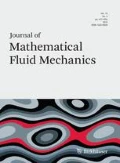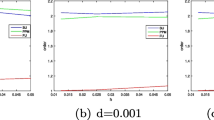Abstract
A distributed optimal control problem for the 2D incompressible Navier–Stokes equation with delay in the convection term is studied. The delay corresponds to the non-instantaneous effect of the motion of a fluid parcel on the mass transfer, and can be realized as a regularization or stabilization to the Navier–Stokes equation. The existence of optimal controls is established, and the corresponding first-order necessary optimality system is determined. A semi-implicit discontinuous Galerkin scheme with respect to time and conforming finite elements for space is considered. Error analysis for this numerical scheme is discussed and optimal convergence rates are proved. The fully discrete problem is solved by the Barzilai-Borwein gradient method. Numerical examples for the velocity-tracking and vorticity minimization problems based on the Taylor-Hood elements are presented.




Similar content being viewed by others
References
Abergel, F., Temam, R.: On some control problems in fluid mechanics. Theor. Comput. Fluid Dyn. 1, 303–325 (1990). https://doi.org/10.1007/BF00271794
Adams, R.A.: Sobolev Spaces. Academic Press, New York (1975)
Arnold, D.N., Brezzi, F., Fortin, M.: A stable finite element for the Stokes equation. Calcolo 21, 337–344 (1984). https://doi.org/10.1007/BF02576171
Azmi, B., Kunisch, K.: Analysis and performance of the Barzilai–Borwein step-size rules for optimization problems in Hilbert spaces. J. Optim. Theory Appl. 185, 819–844 (2020)
Banks, H.T., Burns, J.A.: Hereditary control problems: numerical methods based on averaging approximations. SIAM J. Control Optim. 16, 169–208 (1978). https://doi.org/10.1137/0316013
Barzilai, J., Borwein, J.: Two-point step size gradient method. IMA J. Numer. Anal. 8(1), 141–148 (1988). https://doi.org/10.1093/imanum/8.1.141
Bessaih, H., Garrido-Atienza, M.J., Schmalfuß, B.: On 3d Navier-Stokes equations: regularization and uniqueness by delays. Physica D Nonlinear Phenomena 376–377, 228–237 (2018). https://doi.org/10.1016/j.physd.2018.03.004
Boffi, D., Brezzi, F., Fortin, M.: Mixed Finite Element Methods and Applications, Vol. 44 of Springer Series in Computational Mathematics. Springer, Heidelberg (2013)
Caraballo, T., Real, J.: Navier–Stokes equations with delays. Proc. R. Soc. Lond. A 457, 2441–2453 (2001). https://doi.org/10.1098/rspa.2001.0807
Casas, E.: Optimality conditions for some control problems of turbulent flow, In: Gunzburger M.D. (eds) Flow Control. The IMA Volumes in Mathematics and its Applications, Vol 68. Springer, New York, NY, pp. 127–147 (1995). https://doi.org/10.1007/978-1-4612-2526-3_6
Casas, E., Chrysafinos, K.: A discontinuous Galerkin time-stepping scheme for the velocity tracking problem. SIAM J. Numer. Anal. 50(5), 2281–2306 (2012). https://doi.org/10.1137/110829404
Casas, E., Mateos, M., Raymond, J.-P.: Error estimates for the numerical approximation of a distributed control problem for the steady-state Navier–Stokes equations. SIAM J. Control Optim. 46(3), 952–982 (2007). https://doi.org/10.1137/060649999
Chrysafinos, K.: Analysis and finite element error estimates for the velocity tracking problem for Stokes flows via penalized formulation. ESAIM Control Optim. Calc. Var. 10(4), 574–592 (2004). https://doi.org/10.1051/cocv:2004021
Chrysafinos, K.: Error estimates for the velocity tracking problem for Navier–Stokes flows based on the artificial compressibility formulation. Numer. Func. Anal. Opt. 26(7–8), 773–812 (2005). https://doi.org/10.1080/01630560500377311
Chrysafinos, K.: Error estimates for time-discretizations for the velocity tracking problem for the Navier–Stokes flows by penalty methods. Discrete Cont. Dyn. B 6(5), 1077–1096 (2006). https://doi.org/10.3934/dcdsb.2006.6.1077
Chrysafinos, K., Walkington, N.J.: Discontinuous Galerkin approximations of the Stokes and Navier–Stokes equations. Math. Comput. 79, 2135–2167 (2010). https://doi.org/10.1090/S0025-5718-10-02348-3
Ciarlet, P. G.: The Finite Element Method for Elliptic Problems, Vol. 4 of Studies in Mathematics and Its Applications. North-Holland, Amsterdam (1978)
Constantin, P., Foias, C.: Navier–Stokes Equations. Chicago Lectures in Mathematics. The University of Chicago Press, Chicago (1988)
Dai, Y.-H., Fletcher, R.: Projected Barzilai–Borwein methods for large-scale box constrained quadratic programming. Numer. Math. 100, 21–47 (2005). https://doi.org/10.1007/s00211-004-0569-y
Deckelnick, K., Hinze, M.: Error estimates in space and time for tracking-type control of the instationary Stokes system. In: Desch, W., Kappel, F., Kunisch, K. (eds.) Control and Estimation of Distributed Parameter Systems, pp. 87–103. Birkhäuser, Basel (2003). https://doi.org/10.1007/978-3-0348-8001-5_6
Deckelnick, K., Hinze, M.: Semidiscretization and error estimates for distributed control of the instationary Navier-Stokes equations. Numer. Math. 97, 297–320 (2004). https://doi.org/10.1007/s00211-003-0507-4
Dunford, N., Schwartz, J.Y.: Linear Operators, vol. I. General Theory. Intersci. Publ, New York (1958)
Ern, A., Guermond, J..-L.: Theory and Practice of Finite Elements. Springer, New York (2004). https://doi.org/10.1007/978-1-4757-4355-5
Foias, C., Manley, O., Rosa, R., Temam, R.: Navier–Stokes Equations and Turbulence. Cambridge University Press, Encyclopedia of Mathematics and its Applications (2001)
Fursikov, A.V.: On some control problems and results related to the unique solution of mixed problems by the three-dimensional Navier–Stokes and Euler equations. Dokl. Akad. Nauk SSSR 252(5), 1066–1070 (1980)
Fursikov, A.V.: Control problems and theorems concerning on the unique solvability of a mixed boundary value problem for the three-dimensional Navier-Stokes and Euler equations. Mat. USSR-Sb. 43(2), 251–273 (1982). https://doi.org/10.1070/sm1982v043n02abeh002447
Fursikov, A.V.: Properties of solutions of certain extremum problems related to the Navier–Stokes and Euler equations. Mat. USSR-Sb. 46(3), 323–351 (1983). https://doi.org/10.1070/sm1983v046n03abeh002796
Gao, X., Gao, H.: Existence and uniqueness of weak solutions to stochastic 3d Navier–Stokes equations with delays. Appl. Math. Lett. 95, 158–164 (2019). https://doi.org/10.1016/j.aml.2019.03.037
Guzzo, S.M., Planas, G.: On a class of three dimensional Navier-Stokes equations with bounded delay. Discrete Contin. Dyn. Syst. Ser. B 16(1), 225–238 (2011). https://doi.org/10.3934/dcdsb.2011.16.225
Girault, V., Raviart, P..-A.: Finite Element Methods for Navier–Stokes Equations: Theory and Algorithms, Vol. 5 of Springer Series in Computational Mathematics. Springer, Berlin (1986). https://doi.org/10.1007/978-3-642-61623-5
Gunzburger, M.D., Maservisi, S.: The velocity tracking problem for Navier–Stokes flows with bounded distributed controls. SIAM J. Control Optim. 37(6), 1913–1945 (1999). https://doi.org/10.1137/S0363012998337400
Gunzburger, M.D., Maservisi, S.: Analysis and approximation of the velocity tracking problem for Navier-Stokes flows with distributed control. SIAM J. Numer. Anal. 37(5), 1481–1512 (2000). https://doi.org/10.1137/S0036142997329414
He, Y.: Two-level method based on finite element and Crank–Nicolson extrapolation for the time-dependent Navier–Stokes equations. SIAM J. Numer. Anal. 41(4), 1263–1285 (2003). https://doi.org/10.1137/S0036142901385659
He, Y., Li, K.: Convergence and stability of finite element nonlinear Galerkin method for the Navier–Stokes equations. Numer. Math. 79, 77–106 (1998). https://doi.org/10.1007/s002110050332
He, Y., Li, K.: Nonlinear Galerkin method and two-step method for the Navier–Stokes equations. Numer. Methods Partial Differ. Equ. 12(3), 283–305 (1996)
He, Y., Sun, W.: Stability and convergence of the Crank–Nicolson/Adams–Bashforth scheme for the time-dependent Navier–Stokes equations. SIAM J. Numer. Anal. 45(2), 837–869 (2007). https://doi.org/10.1137/050639910
Heywood, J.G., Rannacher, R.: Finite-element approximations of the nonstationary Navier–Stokes problem. Part IV: error estimates for second-order time discretization. SIAM J. Numer. Anal. 27(2), 353–384 (1990). https://doi.org/10.1137/0727022
Hinze, M., Kunisch, K.: Second order methods for optimal control of time-dependent fluid flow. SIAM J. Control Optim. 40(3), 925–946 (2001). https://doi.org/10.1137/S0363012999361810
Kellog, R.B., Osborn, J.E.: A regularity result for the Stokes problem in a convex polygon. J. Func. Anal. 21(4), 397–431 (1976). https://doi.org/10.1016/0022-1236(76)90035-5
Lions, J.L.: Optimal Control of Systems Governed by Partial Differential Equations. Grundlehren der mathematischen Wissenschaften, vol. 170. Springer, New York (1971)
Liu, W.: Asymptotic behavior of solutions of time-delayed Burgers’ equation. DCDS Ser. B 2(1), 47–56 (2002). https://doi.org/10.3934/dcdsb.2002.2.47
Marion, M., Temam, R.: Navier–Stokes Equations: Theory and Approximation, Handb. Numer. Anal. VI, North-Holland, Amsterdam, pp. 503–688 (1998). https://doi.org/10.1016/S1570-8659(98)80010-0
Peralta, G., Kunisch, K.: Analysis and finite element discretization for optimal control of a linear fluid-structure interaction problem with delay. IMA J. Numer. Anal. 40(1), 140–206 (2020). https://doi.org/10.1093/imanum/dry070
Quarteroni, A., Valli, A.: Numerical Approximations of Partial Differential Equations. Springer, Heidelberg (2008). https://doi.org/10.1007/978-3-540-85268-1
Roubíc̆ek, T.: Nonlinear Partial Differential Equations with Applications, 2nd edition. Vol. 23 of Springer Series in Computational Mathematics, Birkhäuser, Basel (2013). https://doi.org/10.1007/978-3-0348-0513-1
Simon, J.: Compact sets in \(L^p(0, T; B)\). Ann. Mat. Pur. Appl. 146, 65–96 (1986). https://doi.org/10.1007/BF01762360
Stenberg, R.: Analysis of mixed finite element methods for the Stokes problem: a unified approach. Math. Comput. 42, 9–23 (1984). https://doi.org/10.1090/S0025-5718-1984-0725982-9
Strang, G., Fix, G.: An Analysis of the Finite Element Method. Prentice-Hall Series in Automatic Computation, Prentice-Hall, Englewood Cliffs, NJ (1973)
Temam, R.: Navier–Stokes Equations: Theory and Numerical Analysis, 2nd edn. North Holland, Amsterdam (1979)
Tröltzsch, F.: Optimal Control of Partial Differential Equations: Theory, Methods and Applications. Graduate Studies in Mathematics, vol. 112. American Mathematical Society, Providence, RI (2010)
Varnhorn, W.: Time delay and finite differences for the non-stationary non-linear Navier–Stokes equations. Math. Methods Appl. Sci. 15(2), 89–108 (1992). https://doi.org/10.1002/mma.1670150204
Varnhorn, W.: A fractional step method for regularized Navier-Stokes equations, In: J.G. Heywood, K. Masuda, R. Rautmann R. and V.A Solonnikov V.A. (eds) The Navier-Stokes Equations II: Theory and Numerical Methods, Lecture Notes in Mathematics, vol 1530, Springer, Berlin, Heidelberg (1992). https://doi.org/10.1007/BFb0090343
Wachsmuth, D.: Optimal control of the unsteady Navier-Stokes equations. PhD Thesis, Technischen Universität Berlin (2006). https://depositonce.tu-berlin.de/bitstream/11303/1767/1/Dokument_27.pdf
Zeidler, E.: Applied Functional Analysis and its Applications I: Fixed Point Theorems. Springer, New York (1986)
Acknowledgements
This work was supported in part by the One U.P. Faculty Grant 2019-101374 for G.P. and by the Philippine Department of Science and Technology - Accelerated Science and Technology Human Resource Development Program (DOST-ASTHRDP) for J.S.S. The authors are grateful to the anonymous referees for the comments and suggestions that lead to the improvement of the manuscript.
Author information
Authors and Affiliations
Corresponding author
Ethics declarations
Conflict of interest
The authors declare that they have no conflict of interest.
Additional information
Communicated by S. Turek.
Publisher's Note
Springer Nature remains neutral with regard to jurisdictional claims in published maps and institutional affiliations.
Appendix
Appendix
In the following, an extension of the Gronwall Lemma that is needed in the analysis of the state and linearized state equations is presented. The reader is reminded on the notation of various time intervals in (2.2).
Lemma 7.1
Suppose that \(a \ge 0\), \(\phi \in L^\infty (I_r)\cap L^1(I)\), \(\varphi \in L^1(J_r)\), \(\alpha ,\, \beta ,\, \psi \in L^1(I)\), and \(\gamma \in L^\infty (I)\) are nonnegative and for a.e. \(t \in I\) it holds that
Then \(\phi \in L^\infty (I)\) and there exists a continuous function \({\mathfrak {c}} > 0\) such that
where \({\mathfrak {c}}_{T, r, \alpha , \beta , \gamma } := {\mathfrak {c}}(T, r, \Vert \alpha \Vert _{L^1(I)}, \Vert \beta \Vert _{L^1(I)}, \Vert \gamma \Vert _{L^\infty (I)}).\)
Proof
Let N be the largest positive integer such that \((N-1)r < T \le Nr\), and set \(I_n := [0, nr]\) for \(n=1,\ldots , N\). For each n, we shall demonstrate by induction that
Let us verify this for \(n = 1\). Using the assumption (7.1) restricted to \(t \in I_1\), we can apply the usual Gronwall Lemma so that
On the other hand, (7.1) also yields the following estimate
Substituting (7.3) in the second term of the right hand side in (7.4) and then adding the resulting inequality with (7.3) prove (7.2) for \(n = 1\).
Now, suppose that (7.2) holds for \(n = k\). For \(t \in I_{k+1}\), we obtain from (7.1) that
Thus, applying the Gronwall Lemma once more, one has the estimate
and as a consequence it follows that
The last two inequalities along with the induction hypothesis imply (7.2) for \(n = k+1\). This completes the proof of the induction step. \(\square \)
Next, we recall the following discrete version of the Gronwall Lemma, see [34] for instance. This is utilized in the error analysis of the fully-discrete optimal control problem.
Lemma 7.2
Let \(n \in {\mathbb {N}}\), \(a \ge 0\), \(\{a_k\}_{k=1}^n\), \(\{b_k\}_{k=1}^n\), and \(\{c_k\}_{k=1}^{n-1}\) be nonnegative sequences with
Then it holds that
Rights and permissions
About this article
Cite this article
Peralta, G., Simon, J.S. Optimal Control for the Navier–Stokes Equation with Time Delay in the Convection: Analysis and Finite Element Approximations. J. Math. Fluid Mech. 23, 56 (2021). https://doi.org/10.1007/s00021-021-00577-z
Accepted:
Published:
DOI: https://doi.org/10.1007/s00021-021-00577-z
Keywords
- Delayed Navier–Stokes equation
- Distributed control
- Optimality conditions
- Finite elements
- Discontinuous Galerkin method
- Error estimates




